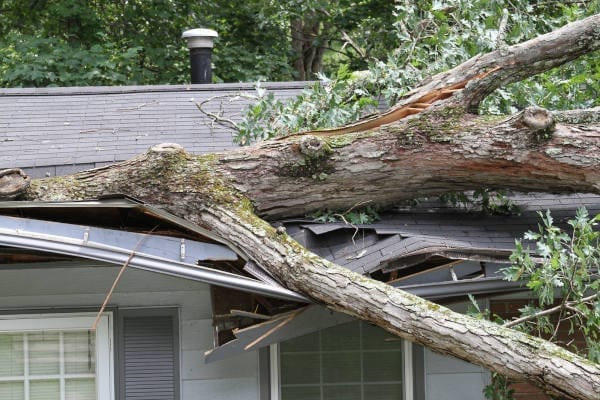How to Tell If Your Leaning Tree is Unsafe and if it can Be Repaired

Does a drooping or leaning tree provide a safety risk? Do they represent a risk to your security? Every Albuquerque resident should be aware of the possible hazards and dangers connected to leaning trees, even if it’s not always simple to discern.
This post will discuss what causes trees to sag, when they become hazardous, and whether or not they can be straightened. You can safeguard the security of your belongings and the people you care about by being aware of the warning signals and knowing when to get expert assistance.
Let’s explore the imbalanced realm of leaning trees and learn the truth about the possible risks associated with them.
What makes a tree lean?
There are several reasons why a tree can slant. Knowing why trees slant is important since it can be used to assess whether or not they are dangerous.
Trees often lean as a result of severe winds or storms. A tree that is leaning can be the consequence of these natural pressures weakening or loosening the roots.
Poor soil conditions might also be a role in a tree’s tilting. Soil that has been compacted excessively might affect a tree’s capacity to extend its roots and function as an anchor. The tree can also tilt as a result of erosion brought on by unstable or improperly draining soil.
A tree’s structure can sometimes be weakened by disease or insect infestation, increasing the likelihood of the tree drooping. For instance, your tree can have root rot if you see mushrooms emerging from the trunk or around the base of the tree.
Recognizing the factors that contribute to a leaning tree—such as severe winds, poor soil, or damage to the roots—will enable you to evaluate the risk and take the necessary precautions.
What should you do when leaning trees become a threat?
Trees that are leaned over might be dangerous, particularly if they are close to buildings or in busy places. To solve the problem and guarantee the safety of your surrounds, it is advised that you get in touch with a professional tree service if you have a leaning tree on your property.
The angle of the lean is one of the key elements in figuring out if a leaning tree is hazardous. A tree’s root system can be affected, or its structural integrity can be challenged if it is lopsided (leaning more than 45 degrees usually indicates a high probability of collapse). As a consequence, during severe winds or storms, the tree can be more prone to falling. You should also take into account how fast the lean happened. Compared to a tree that has started to lean gradually over time, a tree that leans fast is more likely to fail.
The state of the tree itself is another thing to consider. The likelihood of the tree falling increases if it exhibits symptoms of illness, decay, or insect infestation. The tree’s structure can be weakened by these problems, increasing the likelihood of collapse. Furthermore, a tree’s danger of falling can rise if it has a lot of deadwood or massive dead limbs.
Once again, the likelihood of a leaning tree collapsing might be further increased by the existence of other stresses like heavy rain or moist soil. The tree can become more prone to toppling over as a result of these circumstances weakening its root system.
When a tree is severely leaned, exhibits weakening or decay, is next to a building, or is subject to other stresses, it might become hazardous. In order to reduce any possible risk, it’s critical to evaluate the risk provided by a leaning tree and take the necessary steps, such as speaking with a qualified arborist.
Can I fix all leaning trees?
A leaning tree can be straightened by hiring a qualified arborist to evaluate and treat the problem. While certain leaning trees can be dangerous and should be destroyed because they can endanger your property and safety, this is not always the case. They can be preserved and corrected in certain situations.
Contacting an arborist with expertise in structural support and evaluation is the first step towards correcting a leaning tree. To ascertain the reason for the lean and appraise the tree’s general health, they will carry out an extensive examination. They can create a strategy to repair the tree with the assistance of this examination.
Tree bracing or cabling is a popular technique for straightening a leaning tree. Installing wires or braces to support the tree and stop it from leaning any farther or perhaps falling is the adding of structural support. The hardware will be carefully chosen by the arborist and installed so as to provide the required support without endangering the tree.
For some leaning trees, another alternative is to straighten the tree. Using a rope to secure the leaning tree’s trunk, pull it straight gradually while varying the rope’s tension as the tree advances. Imagine it as the process by which an orthodontist progressively straightens teeth over time by occasionally tightening branches.
It’s important to remember that not every leaning tree can be straightened. Removing the tree could be the only choice if it is too sick, too damaged, or located in a hazardous area. Your hired arborist will be able to advise you on whether it would be better to remove or repair the tree.
Get the help of tree care experts
You will not be able to deal with leaning trees on your own. This is why it is important to seek the assistance of tree care experts. Make sure to get in touch with the right company and receive much-needed assistance with overcoming the threat of a leaning tree.
